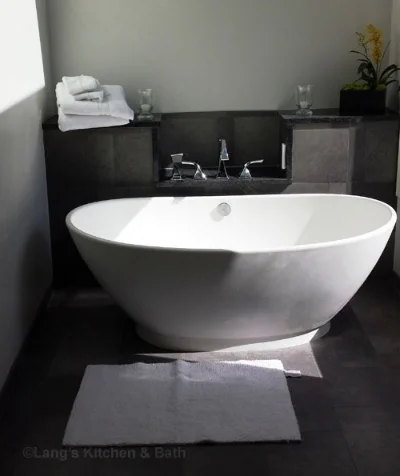Choosing a Freestanding Tub For Your Bath Remodel
/According to the latest design trends, many people consider a bathtub to be outdated or unnecessary in a bathroom renovation. They may remove a tub to leave more space and budget for other features like an extra-large shower or a larger vanity with specialized storage. These are all excellent bathroom remodeling ideas, but for some people nothing can replace the feeling of a soothing soak in the tub. If a bath is your idea of the ultimate in relaxation, then design trends should not keep you from including it in your new bathroom design!
It is easy to see why freestanding tubs are by far the most popular trend in bathtubs. Available in a range of size, shapes, and styles, these tubs are far more than functional. They change the tone of a bathroom by turning it into a relaxing sanctuary, and as a clear focal point in any bathroom they greatly impact the style of the room. These tub styles frequently conjure images of very large bathrooms, but they can be positioned almost anywhere in the room and are available in a range of sizes making them an option for many bathrooms.
Is a freestanding tub the right choice for you? If you are 100 percent happy with only having a shower in your home, then remove the tub and use that space for something that will better fulfill your life. If the idea of having no tub leaves you feeling cold, then consider a freestanding tub that will elevate your design to a relaxing haven. Here are some tips on how to select this style icon for your bathroom design.
Where will it go?
There are many options for locating a freestanding tub, from the middle of the room to a niche next to a window. Before you finalize the location, determine how much floorspace is necessary for your tub and what other elements of your bathroom will surround it. Make sure there are no obstructions nearby by considering the swing of doors and vanity drawers, as well as the overall layout and flow of traffic through the room. If you opt to position the tub in the center of the room, remember this may limit your options for placing faucets and accessible storage for bath toiletries. Some tubs have special installation requirements depending on the size, shape, and weight of the tub. Be sure to check the suitability of your room for your chosen tub.
How will it be filled?
Some freestanding tubs come with holes drilled in the tub wall or tub deck to accommodate faucets. If your chosen variety of tub does not come this way, you may opt to use faucets that come from the floor or from a surrounding wall like the one shown here, depending on the position of your tub.
What type of tub?
Now, for the fun part! Freestanding tubs range from streamlined contemporary styles to footed tubs with an old world charm. As a focal point, what statement do you want your tub to make? There is a tub style to fit any bathroom:
Floor-set tubs sit directly on the floor and are available in a range of shapes including D-shape, oval, square, rectangular, round, and free form.
Footed tubs are generally associated with claw foot tubs evoking a classic style, like this tub. There are more modern versions of this tub style with ball or block type feet.
Slipper tubs are oblong shaped and have a sloped, tall end (or sometimes two tall ends) intended for resting the head and reclining.
Pedestal tubs are raised off of the floor on either a pedestal or plinth, and can bring out a variety of styles depending on the type of pedestal, like the one pictured below.
Japanese soaking tubs are extra deep tubs intended for submersing the body for a fully relaxing experience.
Most tubs are available in a range of materials including resin, copper, stainless steel, cast iron, wood, and more. Contact us to find the right freestanding tub to suit your design and look for more bathroom remodeling ideas in our bathroom design gallery here!





